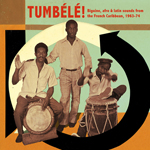|
|
 |
Dusted Reviews
Artist: V/A Album: Tumbélé!: Biguine, Afro & Latin Sounds from the French Caribbean, 1963-74 Label: Soundway Review date: Dec. 7, 2009 |

|
|
|
 |
The fashion for tumbélé may have been short lived, but the sounds on this Soundway release offer a glimpse into a key musical style that contributed to the making of the widely popular zouk music that took over the Caribbean in the 1970s and ‘80s. Tumbélé! testifies to the movement of people, cultures and traditions – from Africa to the Caribbean to Europe, back to Africa, and then circulating back to the musical centers on the Caribbean islands, picking up new sounds and technologies all along the way. For the disc, Hugo Mendez and his team researched and compiled popular music from the colonial Lesser Antilles, which include Guadeloupe, Martinique and Dominica. It’s a real treat to hear the sounds on this compilation, which teaches listeners about a particular movement in Francophone Caribbean musical culture. It comes across as a surprise that this music hasn’t received much dedicated attention in the English-speaking world.
The mixture of African and Afro-Caribbean styles that went into the making of the tumbélé sound include Congolese rumba, Haitian compass, Cuban percussion and Antillean beguine. It also includes predecessors like the rustic rhythms of gwo-ka and the urban calypso. That said, only two tracks on the compilation are actually labeled as having a tumbélé rhythm: the catchy “D’Leau Coco” by Les Léopards from Martinique (whose lead singer Albert Nadeau later became a zouk star in the late 1970s) and “Panty” by Monsieur Dolor et Les Guitar Boys. But even these tracks, with their Afro-Cuban grooves and glorious reverb are combinations of various urban and rural, local and transnational styles represented on the rest of the album.
The shuffling beats of the biguine are one of the most prominent on the compilation. Biguine clearly has ties to le hot jazz of early 20th century Paris and the contradanse of high society salons, but the tracks also draw on popular studio recording techniques and electric instruments familiar from rock music of the 1960s and ‘70s. The results can be as trippy as the “Jet Beguine” by Les Loups Noirs D’Haiti, one of the most popular Haitian bands of their time. “Jet Beguine” blends a beguine rhythm with smooth vocals, wailing saxophones, a psychedelic organ, and finally, a simulated departure of an Air France jet headed for Haiti. Not surprisingly, Les Loups Noirs spent much of their time travelling from one Haitian community to another from New York, Toronto and the Caribbean.
Maybe it’s a misnomer to call the album Tumbélé! if there are only two tracks which have what the producers seem to call a tumbélé. But this compilation tells the story of a rhythm not fixed in place or in meaning. The album title demonstrates how tumbélé is really a hybrid of all the sounds it hears on its voyages. In other words, the emphasis has to be on movement and transformation, and the impossibility of giving a name. Tumbélé! , then, is a sort of triumph of stylistic confusion.
By Miki Kaneda
|







